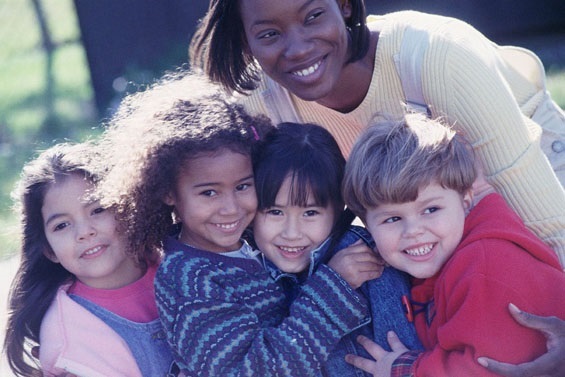 One-to-one and one-to-small group tutoring have long existed as remedial approaches for students who are performing far below expectations. Everyone knows that tutoring works, and nothing in this blog contradicts this. Although different approaches have their champions, the general consensus is that tutoring is very effective, and the problem with widespread use is primarily cost (and for tutoring by teachers, availability of sufficient teachers). If resources were unlimited, one-to-one tutoring would be the first thing most educators would recommend, and they would not be wrong. But resources are never unlimited, and the numbers of students performing far below grade level are overwhelming, so cost-effectiveness is a serious concern. Further, tutoring seems so obviously effective that we may not really understand what makes it work.
One-to-one and one-to-small group tutoring have long existed as remedial approaches for students who are performing far below expectations. Everyone knows that tutoring works, and nothing in this blog contradicts this. Although different approaches have their champions, the general consensus is that tutoring is very effective, and the problem with widespread use is primarily cost (and for tutoring by teachers, availability of sufficient teachers). If resources were unlimited, one-to-one tutoring would be the first thing most educators would recommend, and they would not be wrong. But resources are never unlimited, and the numbers of students performing far below grade level are overwhelming, so cost-effectiveness is a serious concern. Further, tutoring seems so obviously effective that we may not really understand what makes it work.
In recent reviews, my colleagues and I examined what is known about tutoring. Beyond the simple conclusion that “tutoring works,” we found some big surprises, four “shockers.” Prepare to be amazed! Further, I propose an explanation to account for these unexpected findings.
We have recently released three reviews that include thorough, up-to-date reviews of research on tutoring. One is a review of research on programs for struggling readers in elementary schools by Amanda Inns and colleagues (2018). Another is a review on programs for secondary readers by Ariane Baye and her colleagues (2017). Finally, there is a review on elementary math programs by Marta Pellegrini et al. (2018). All three use essentially identical methods, from the Best Evidence Encyclopedia (www.bestevidence.org). In addition to sections on tutoring strategies, all three also include other, non-tutoring methods directed at the same populations and outcomes.
What we found challenges much of what everyone thought they knew about tutoring.
Shocker #1: In all three reviews, tutoring by paraprofessionals (teaching assistants) was at least as effective as tutoring by teachers. This was found for reading and math, and for one-to-one and one-to-small group tutoring. For struggling elementary readers, para tutors actually had higher effect sizes than teacher tutors. Effect sizes were +0.53 for paras and +0.36 for teachers in one-to-one tutoring. For one-to-small group, effect sizes were +0.27 for paras, +0.09 for teachers.
Shocker #2: Volunteer tutoring was far less effective than tutoring by either paras or teachers. Some programs using volunteer tutors provided them with structured materials and extensive training and supervision. These found positive impacts, but far less than those for paraprofessional tutors. Volunteers tutoring one-to-one had an effect size of +0.18, paras had an effect size of +0.53. Because of the need for recruiting, training, supervision, and management, and also because the more effective tutoring models provide stipends or other pay, volunteers were not much less expensive than paraprofessionals as tutors.
Shocker #3: Inexpensive substitutes for tutoring have not worked. Everyone knows that one-to-one tutoring works, so there has long been a quest for approaches that simulate what makes tutoring work. Yet so far, no one, as far as I know, has found a way to turn lead into tutoring gold. Although tutoring in math was about as effective as tutoring in reading, a program that used online math tutors communicating over the Internet from India and Sri Lanka to tutor students in England, for example, had no effect. Technology has long been touted as a means of simulating tutoring, yet even when computer-assisted instruction programs have been effective, their effect sizes have been far below those of the least expensive tutoring models, one-to-small group tutoring by paraprofessionals. In fact, in the Inns et al. (2018) review, no digital reading program was found to be effective with struggling readers in elementary schools.
Shocker #4: Certain whole-class and whole-school approaches work as well or better for struggling readers than tutoring, on average. In the Inns et al. (2018) review, the average effect size for one-to-one tutoring approaches was +0.31, and for one-to-small group approaches it was +0.14. Yet the mean for whole-class approaches, such as Ladders to Literacy (ES = +0.48), PALS (ES = +0.65), and Cooperative Integrated Reading and Composition (ES = +0.19) averaged +0.33, similar to one-to-one tutoring by teachers (ES = +0.36). The mean effect sizes for comprehensive tiered school approaches, such as Success for All (ES = +0.41) and Enhanced Core Reading Instruction (ES = +0.22) was +0.43, higher than any category of tutoring (note that these models include tutoring as part of an integrated response to implementation approach). Whole-class and whole-school approaches work with many more students than do tutoring models, so these impacts are obtained at a much lower cost per pupil.
Why does tutoring work?
Most researchers and others would say that well-structured tutoring models work primarily because they allow tutors to fully individualize instruction to the needs of students. Yet if this were the only explanation, then other individualized approaches, such as computer-assisted instruction, would have outcomes similar to those of tutoring. Why is this not the case? And why do paraprofessionals produce at least equal outcomes to those produced by teachers as tutors? None of this squares with the idea that the impact of tutoring is entirely due to the tutor’s ability to recognize and respond to students’ unique needs. If that were so, other forms of individualization would be a lot more effective, and teachers would presumably be a lot more effective at diagnosing and responding to students’ problems than would less highly trained paraprofessionals. Further, whole-class and whole-school reading approaches, which are not completely individualized, would have much lower effect sizes than tutoring.
My theory to account for the positive effects of tutoring in light of the four “shockers” is this:
- Tutoring does not work due to individualization alone. It works due to individualization plus nurturing and attention.
This theory begins with the fundamental and obvious assumption that children, perhaps especially low achievers, are highly motivated by nurturing and attention, perhaps far more than by academic success. They are eager to please adults who relate to them personally. The tutoring setting, whether one-to-one or one-to-very small group, gives students the undivided attention of a valued adult who can give them personal nurturing and attention to a degree that a teacher with 20-30 students cannot. Struggling readers may be particularly eager to please a valued adult, because they crave recognition for success in a skill that has previously eluded them.
Nurturing and attention may explain the otherwise puzzling equality of outcomes obtained by teachers and paraprofessionals as tutors. Both types of tutors, using structured materials, may be equally able to individualize instruction, and there is no reason to believe that paras will be any less nurturing or attentive. The assumption that teachers would be more effective as tutors depends on the belief that tutoring is complicated and requires the extensive education a teacher receives. This may be true for very unusual learners, but for most struggling students, a paraprofessional may be as capable as a teacher in providing individualization, nurturing, and attention. This is not to suggest that paraprofessionals are as capable as teachers in every way. Teachers have to be good at many things: preparing and delivering lessons, managing and motivating classes, and much more. However, in their roles as tutors, teachers and paraprofessionals may be more similar.
Volunteers certainly can be nurturing and attentive, and can be readily trained in structured programs to individualize instruction. The problem, however, is that studies of volunteer programs report difficulties in getting volunteers to attend every day and to avoid dropping out when they get a paying job. This is may be less of a problem when volunteers receive a stipend; paid volunteers are much more effective than unpaid ones.
The failure of tutoring substitutes, such as individualized technology, is easy to predict if the importance of nurturing and attention is taken into account. Technology may be fun, and may be individualized, but it usually separates students from the personal attention of caring adults.
Whole-Class and Whole-School Approaches.
Perhaps the biggest shocker of all is the finding that for struggling readers, certain non-technology approaches to instruction for whole classes and schools can be as effective as tutoring. Whole-class and whole-school approaches can serve many more students at much lower cost, of course. These classroom approaches mostly use cooperative learning and phonics-focused teaching, or both, and the whole-school models especially Success for All, combine these approaches with tutoring for students who need it.
The success of certain whole-class programs, of certain tutoring approaches, and of whole-school approaches that combine proven teaching strategies with tutoring for students who need more, argues for response to intervention (RTI), the policy that has been promoted by the federal government since the 1990s. So what’s new? What’s new is that the approach I’m advocating is not just RTI. It’s RTI done right, where each component of the strategy has strong evidence of effectiveness.
The good news is that we have powerful and cost-effective tools at our disposal that we could be putting to use on a much more systematic scale. Yet we rarely do this, and as a result far too many students continue to struggle with reading, even ending up in special education due to problems schools could have prevented. That is the real shocker. It’s up to our whole profession to use what works, until reading failure becomes a distant memory. There are many problems in education that we don’t know how to solve, but reading failure in elementary school isn’t one of them.
Practical Implications.
Perhaps the most important practical implication of this discussion is a realization that benefits similar or greater than those of one-to-one tutoring by teachers can be obtained in other ways that can be cost-effectively extended to many more students: Using paraprofessional tutors, using one-to-small group tutoring, or using whole-class and whole-school tiered strategies. It is no longer possible to say with a shrug, “of course tutoring works, but we can’t afford it.” The “four shockers” tell us we can do better, without breaking the bank.
References
Baye, A., Lake, C., Inns, A., & Slavin, R. (2017). Effective reading programs for secondary students. Manuscript submitted for publication. Also see Baye, A., Lake, C., Inns, A. & Slavin, R. E. (2017, August). Effective Reading Programs for Secondary Students. Baltimore, MD: Johns Hopkins University, Center for Research and Reform in Education.
Inns, A., Lake, C., Pellegrini, M., & Slavin, R. (2018). Effective programs for struggling readers: A best-evidence synthesis. Paper presented at the annual meeting of the Society for Research on Educational Effectiveness, Washington, DC.
Pellegrini, M., Inns, A., & Slavin, R. (2018). Effective programs in elementary mathematics: A best-evidence synthesis. Paper presented at the annual meeting of the Society for Research on Educational Effectiveness, Washington, DC.
This blog was developed with support from the Laura and John Arnold Foundation. The views expressed here do not necessarily reflect those of the Foundation.




 One-to-one and one-to-small group tutoring have long existed as remedial approaches for students who are performing far below expectations. Everyone knows that tutoring works, and nothing in this blog contradicts this. Although different approaches have their champions, the general consensus is that tutoring is very effective, and the problem with widespread use is primarily cost (and for tutoring by teachers, availability of sufficient teachers). If resources were unlimited, one-to-one tutoring would be the first thing most educators would recommend, and they would not be wrong. But resources are never unlimited, and the numbers of students performing far below grade level are overwhelming, so cost-effectiveness is a serious concern. Further, tutoring seems so obviously effective that we may not really understand what makes it work.
One-to-one and one-to-small group tutoring have long existed as remedial approaches for students who are performing far below expectations. Everyone knows that tutoring works, and nothing in this blog contradicts this. Although different approaches have their champions, the general consensus is that tutoring is very effective, and the problem with widespread use is primarily cost (and for tutoring by teachers, availability of sufficient teachers). If resources were unlimited, one-to-one tutoring would be the first thing most educators would recommend, and they would not be wrong. But resources are never unlimited, and the numbers of students performing far below grade level are overwhelming, so cost-effectiveness is a serious concern. Further, tutoring seems so obviously effective that we may not really understand what makes it work.




